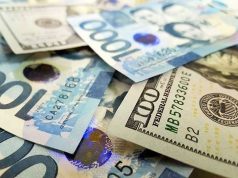Peso may strengthen on weak US economic data
THE PESO may climb further against the dollar as the market continues to price in weak data out of the United States.
The local unit closed at P51.73 against the greenback on Friday, rising 8.5 centavos from its P51.815-a-dollar finish on Thursday.
Week on week, it strengthened by 14 centavos from the P51.875-per-dollar close on Sept. 27.
“The stronger peso can be attributed to the lower-than-expected headline inflation print for September,” Union Bank of the Philippines, Inc. chief economist Ruben Carlo O. Asuncion said in a text message.
Meanwhile, another trader attributed the weak dollar to the US non-manufacturing data.
Headline inflation eased further to 0.9% in September, the slowest in three years, amid lower food prices and electricity rates, the Philippine Statistics Authority reported on Friday. This compares to the 1.7% logged in August and the 6.7% print in the same month last year.
Last month’s inflation print fell at the low end of the Bangko Sentral ng Pilipinas’ (BSP) 0.6-1.4% forecast for September. It was also below the 1.1% median estimate in BusinessWorld’s poll of 16 economists.
For the nine months to September, headline inflation averaged at 2.8%, well within the BSP’s 2-4% target range for 2019.
Both Mr. Asuncion and the trader said that the peso’s performance this week will be dependent on how the market will react to key economic data releases.
The trader said the peso’s performance this week is likely to be dictated by key US data releases such as the nonfarm payrolls and the unemployment rate.
“If data suggests weakness, the weak dollar sentiment may continue this week,” the trader said.
US services sector activity slowed to a three-year low in September amid rising concerns about tariffs, suggesting that trade tensions were spilling over to the broader economy.
The Institute for Supply Management (ISM) said its non-manufacturing activity index fell to a reading of 52.6 in September, the lowest since August 2016, from 56.4 in August. A reading above 50 indicates expansion in the services sector, which accounts for more than two-thirds of US economic activity.
The ISM reported on Tuesday that its measure of national manufacturing activity plunged in September to its lowest level since June 2009, when the Great Recession was ending.
The US economy is chugging along despite the headwinds it faces, Federal Reserve Chair Jerome Powell said on Friday, in remarks that gave little more away about the path of monetary policy.
“While not everyone fully shares economic opportunities and the economy faces some risks, overall it is — as I like to say — in a good place. Our job is to keep it there as long as possible,” Mr. Powell said in brief remarks introducing a “Fed Listens” event at the US central bank’s headquarters in Washington.
The Fed cut interest rates for the first time in more than a decade in July and did so again at its subsequent policy meeting in September in what Mr. Powell and some others have characterized as “insurance” against risks to the economy.
US job growth increased moderately in September and the unemployment rate dropped to near a 50-year low, the US Labor department reported on Friday, allaying concerns the economy is nearing recession.
Mr. Asuncion sees the peso moving within P51.50-51.80 versus the dollar.
Meanwhile, the trader expects the peso to range around P51.60-52.20, depending on data from the world’s largest economy. — L.W.T. Noble with Reuters



